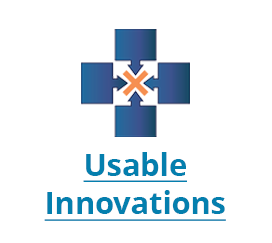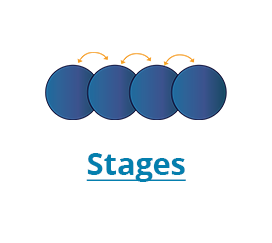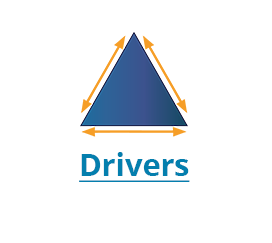Start Here
Active Implementation Learner Pathways
Learning pathways in implementation science serve as structured routes for individuals to effectively acquire the necessary knowledge, skills, and competencies to translate evidence-based interventions into real-world settings.
Activity: Getting started with Implementation Teams
So, how could you leverage the Implementation Teams framework in your work? Consider the following questions when creating teaming structures to support new programs and innovations. Discuss these with your team and/or to write down your responses.
Handout: Implementation Teams One-Pager
Implementation Teams support the full, effective, and sustained use of effective instruction and behavior methods. Linked Implementation Teams define an infrastructure to help assure dramatically and consistently improved student
outcomes.
Implementation Teams Overview (Module 3)
Formally known as “modules” on the AI Hub, we have condensed the information into document overviews. As you begin your journey, take a moment to read about Implementation Teams.
Dive Deeper: Read
Brief: Engaging Critical Perspectives
In educational spaces, it is no longer aspirational but imperative that the community—with its richness and diversity—joins educators as key instructional partners to liberate the creativity, uniqueness, and potential of all students. As educators, we can miss the value of this collaboration. This brief defines critical perspectives, why engagement is necessary, how to select and engage critical perspectives, and evaluate the process.
Brief: Leading by Doing: A Practice-Based Approach to Improving Mathematics Outcomes
Using a practice-based approach to improving mathematics outcomes, the Kentucky Department of Education (KDE) facilitated a continuous improvement process led by teachers and educators to improve mathematics outcomes for all students. This brief focuses on Madison County School District, highlighting how Madison's administration, teachers, and instructional coaches worked together to enhance instructional practices and improve mathematics outcomes.
Co-Designing Regional Models for Colorado Multi-Tiered System of Supports
SISEP Blog: Co-Designing Regional Models for Colorado Multi-Tiered System of Supports
Colorado MTSS Communication Planning Tool
Example in Practice: The Colorado Multi-Tiered System of Supports (COMTSS) Communication Planning tool provides a structured process to guide teams to effectively communicate with internal and external stakeholders.
Communication: An Essential Component Within Implementation
SISIEP Blog: Communication: An Essential Component of Implementation
Effective Teams
SISEP Blog: Effective Teams
Four Key Actions for State Education Agency Teams to Support Implementation of Multi-Tiered Systems of Support
The State Education Agency (SEA) plays a critical role in the implementation fidelity, sustainability, and scale-up of MTSS. Learn more about four key actions SEAs can take to support MTSS in this brief co-developed by the SISEP and PBIS TA centers.
Guidance for Engaging Critical Perspectives
Guidance for Engaging Critical Perspectives
Handout: Implementation Teams in Education
This resource contains handouts for the various teams that may be involved in an educational setting. The resources span from state-level agencies to build-level in the teaming cascade.
Handout: Executive Sponsors or Leaders
Executive Leadership Sponsors champion and support State Transformation Specialists as they lead systemic change efforts across state, regional, district, and school levels.
Handout: Implementation Teams One-Pager
Implementation Teams support the full, effective, and sustained use of effective instruction and behavior methods. Linked Implementation Teams define an infrastructure to help assure dramatically and consistently improved student
outcomes.
Implementation Teams Overview (Module 3)
Formally known as “modules” on the AI Hub, we have condensed the information into document overviews. As you begin your journey, take a moment to read about Implementation Teams.
Navigating the Implementation Cs: Back to School Reminders and Tips
SISEP Blog: Navigating the Implementation Cs: Back to School Reminders and Tips
Regional Education Agencies: The Critical Link Between the State and the Classroom
SISEP blog: Regional Education Agencies: The Critical Link Between the State and the Classroom
Scaling-Up Brief 5: Leveraging Change in State Education Systems
Education systems and the units within those systems are highly variable. An implementation infrastructure in
the form of Implementation Teams can be developed to account for the variability.
Scaling-Up Brief 6: Cascading Logic Model
How can a State Education Agency (SEA) actively promote and support organizational and systems change? The answer may lie in a logic model informed by implementation science and characterized by multi-level supports that interact.
The ABCs of Building Organizational Capacity
SISEP Blog: The ABCs of Building Organizational Capacity
Dive Deeper: Watch
Communication Protocol – Linking Teams Interactive Lesson
To be effective, useful to the work of the organization and include all appropriate levels, communication must be strategically planned and consciously monitored. This lesson introduces you to a tool for creating a strategic plan for communication in your organization.
Voices from the Field Video Series (Implementation Teams)
Voices from the Field Video Series: Implementation Teams
Voices from the Field Video Series (Purveyors & Intermediary Orgs)
Voices from the Field Video Series: Purveyors & Intermediary Orgs
Dive Deeper: Listen
Dive Deeper: Reflect
Activity: Creating Hospitable Environments
Are there barriers and/or facilitators in our current system that may be related to EBP implementation? What are the next right steps? Use this handout to help identify issues that may be facilitating or hindering implementation.
Activity: Engaging Community and Building Hospitable Environments
Reflect on your current organization. How would you describe your system, organization or team environment? Use one of the planning tools to assess your environment, then consider plans for potential improvement.
Activity: Getting started with Implementation Teams
So, how could you leverage the Implementation Teams framework in your work? Consider the following questions when creating teaming structures to support new programs and innovations. Discuss these with your team and/or to write down your responses.
Activity: Linking Communication Protocols
By linking communication protocols, organizations form a practice-policy communication cycle. These feedback processes provide supportive policy, funding, and operational environments for new initiatives and systems changes.
Activity: Mapping Feedback and Feed Forward Pathways
Integration of Implementation Drivers is a key facet of doing Active implementation. Using the Implementation Drivers diagram, map your current, then improved information/communication pathways between Drivers. Then name three ways to get there.
Activity: Reflecting on Rationales
Think about a time you were trying to use a new education skill or program. As an individual or with your team, reflect on these questions.
Activity: Team Selection Criteria
You have decided to explore the potential of having an Implementation Team in your building, district, region or state. Looking across your organization, is there an existing team that could be repurposed? Or, do you need to start fresh?
Activity: Working Agreements (Terms of Reference)
Implementation Teams use Terms of Reference (ToR) or Working Agreements to clarify the team's work, help the team stay on mission and orient new members. You can use this activity with your team to organize and articulate a ToR/Working Agreement.
Apply
Activity: Creating an Implementation Team
This activity encourages you to identify potential Implementation Team members and responsibilities of team types, as well as consider team support strategies.
Activity: Team Selection Criteria
You have decided to explore the potential of having an Implementation Team in your building, district, region or state. Looking across your organization, is there an existing team that could be repurposed? Or, do you need to start fresh?
Building Teams Interactive Lesson
After completing this lesson, Building Teams, you will be able to explain the importance of team cohesion and trust, identify team functions, and utilize the Stakeholder Engagement Guidance Tool to create a diverse team.
Communication Protocol – Linking Teams Interactive Lesson
To be effective, useful to the work of the organization and include all appropriate levels, communication must be strategically planned and consciously monitored. This lesson introduces you to a tool for creating a strategic plan for communication in your organization.
Cultivating Leadership Interactive Lesson
After completing this lesson on Cultivating Leaders/Champions and the companion resources, you will be able to explain importance of leadership to implementation efforts, identify key implementation champion activities, and utilize the Champion Engagement Tool.
Dissemination Plan Template
This template provides the basis for developing a Dissemination Plan. The Dissemination Plan aims to identify and authentically engage with an organization's diverse critical perspectives.
Look Fors: Implementation Team Meeting
This observation tool captures facilitation skills of team members during implementation team meetings.
Tool: Champion Identification & Reflection
How do we identify potential champions on a team and engage them in activities and reflective practices? Utilize this Engagement Tool to complete the four-step process of identification and reflection for champions.
Tool: Communication Protocols Worksheet
Communication is important for any program/innovation. Developing and linking communication protocols for new or existing programs establishes a transparent feedback process and furthers the development of a hospitable policy, funding, and operational environment.
Tool: Implementation Team Checklist
This checklist should be completed quarterly by the Implementation Team to monitor the development and use of core implementation components.






